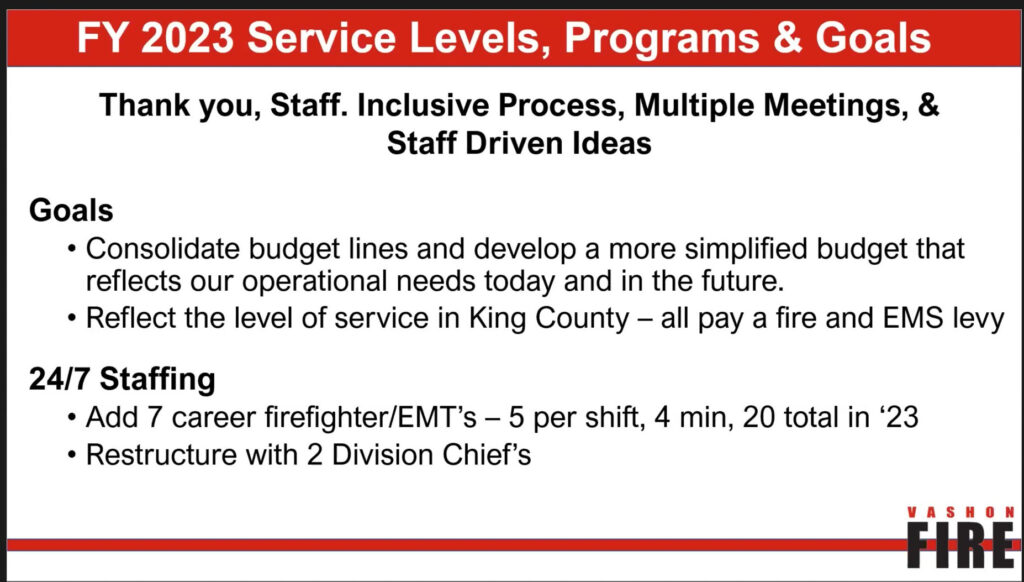By Andy Valencia
In the years we’ve lived on Vashon, I’ve read many an article on Vashon Island Fire and Rescue. All too often, I have finished the article befuddled and no more informed than when I started. As I join the club of people who have written about VIFR, I’m finding a newfound sympathy for my predecessors.
I’ve managed in both corporate and startup environments, and one rule has emerged above all others: Headcount defines the costs of an organization. As you run up the number of employees, the organization’s consumption of funds runs up in tandem. If you need to draw down expenses, you will need to drive down headcount.
This isn’t about saving $100 in office supplies. But when you get into make-or-break finances of any non-trivial organization, headcount is everything.
It was thus with some interest that I viewed the recording of VIFR’s October 20th special meeting presenting their proposed 2023 budget. It featured a recommendation to increase the management head count from 2 to 3, and to increase the firefighter/EMT head count from 13 to 20. The old “manager” instinct in me awoke from its slumber: Management staffing would go up 50%, and employee staffing, 54%. Wow.
I’ve seen growth like that, but only when you’re in the middle of an exploding new market, and you have the tiger by the tail. Vashon population isn’t growing by those sorts of numbers, and neither is our income. Proceed with caution.
In subsequent communications with Chief Matt Vinci, he clarified that two of the firefighter/EMT positions will be funded by existing positions that would be discontinued, and their funding slots then moved over. (At this time, we’ve been told the affected employees are in discussion with their union representation and VIFR.)
Thus we arrive in the latter part of 2022, looking at funding 5 new firefighter/EMT positions. Oddly, the budget line for this headcount increase only went up $200k, which is $40k per person. Way too low. Chief Vinci stated that the current year’s budgeted amount for such employees was much bigger than what was actually used, thus the small increment.
If the amount for 2022 had unused monies in this category, we should see the surplus dropping out at the end of the year. When you go looking for this, you don’t find it. But you do find a very large overtime expense.
This leads us to an emerging picture which seems to match the facts. VIFR has a bigger workload than can be comfortably handled with their current employee count. The overflow is being handled with overtime –extra hours put on full-time firefighters and EMT’s beyond their regular work week. When you hear about overwork and burnout at VIFR, be sure to listen carefully for how much overtime was experienced. The new budget adds employees, and should indeed reduce the need for existing firefighter/EMT’s to work so many overtime hours.
Thus, the new employee costs are addressed by changes like spending less on overtime, along with using the budget of the discontinued “part-time” employee budget line. The latter also helps to fund the new management position. The proposed budget does not need new taxes.
Since headcount is cost, it would be well-advised to pay attention to the details of how VIFR headcount is paid. All firefighter/EMT employees are unionized, and are being paid and receiving raises under a contract that will soon be up for negotiation. Inflation is certainly painful for employees who have seen their raises capped at 3%, and their union will no doubt push to address this in the new contract. It’s unsustainable for inflation to make your purchasing power fade year after year.
VIFR community funding comes from property taxes, an amount based upon assessed value. We’ve been living with wildly climbing prices, but there are many signs that this is an asset bubble in the process of deflating. Thus, an important question: What happens in the perfect storm of a larger VIFR employee count, higher per-head costs, and reduced tax revenues?
Overtime, like spending on consultants, is easy to dial back when finances get tight. Employees are much more painful to cut, and VIFR is proposing to grow the employee count by significant percentages. In a short downturn, there is a general reserve that can cushion a shortfall. Beyond that are options like layoffs or a new funding discussion with the community.
VIFR started as an all-volunteer fire department, which was extremely cost-effective. VIFR still has volunteers, and The Loop will write about them in an upcoming issue. Please get in touch with editor@vashonloop.com if you have information to share on this aspect of Island public safety.
This article is based on interviews and a review of VIFR materials, and was provided to VIFR so they could provide comments and corrections. However. this article is entirely the responsibility of Andy Valencia, who is very willing to respond to further corrections and clarifications. What follows are some supporting data.
Key Data from VIFR
Full-time Employee (FTE) headcount growth:

End of 2021, approved 2022 budget for FTE

Presented 2023 proposed budget from 10/20/2022 meeting (spreadsheet dated 10/18)


